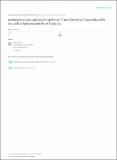| dc.description.abstract | As part of an effort to search for extracts and compounds with new antimicrobial efficacy to fight against bacterial
resistance, the antibacterial activity of Rauvolfia caffra var. caffra (Sond.), a plant of family Apocynaceae used in
Traditional Medicine in Tanzania, was investigated. Ethanol, methanol and water extracts from leaf, stem and root
barks were tested against three species of bacteria namely Escherichia coli (ATCC 25922) (Gram -ve),
Staphylococcus aureus (ATCC 25923) (Gram +ve) and Enterococcus faecalis (ATCC 51299) (Gram +ve) using
Agar-well diffusion assay method and minimum inhibitory concentration on Mueller-Hinton Agar plates. The
extracting solvents were removed by vacuo evaporator to obtain gummy-like extracts. This was then dissolved in
dimethylsulfoxide (10% DMSO). The DMSO without plant extracts was used as a negative control whereas
Gentamicin® as the standard antibiotic was used as a positive control. The Zone of Inhibition (ZOI) measured in
mm and Relative Inhibitory Zone Diameter (RIZD) was calculated. Results showed that R. caffra exhibited
antimicrobial inhibitory activity at a range of 1.25 to 5.0 mg/ml with activity most prominent with methanol extract
(ZOI of 28.33± 0.33 mm and RIZD of 95% for S. aureus; and ZOI of 26.66 ± 0.33 mm for E.coli and 19.0 ± 0.57
mm for E. faecalis at P< 0.05). To characterize further, the alkaloid from the root bark was extracted according to
the standard procedure. The antioxidant activity of the alkaloids and ethanolic extracts was determined using 2,
2-diphenyl-1-picrylhydrazyl (DPPH) and reducing capacity assays. The results indicated that alkaloid fraction of
the root and 80% ethanolic extracts of stem bark exhibited high antioxidant activity. The phytochemical analysis
indicated that R. caffra is rich in alkaloids, anthraquinones, anthocyanoides, flavonoids, saponins, tannis and
reducing sugars. This study provides supportive evidence that methanol and ethanol extracts of R. caffra can be
used as herbal medicine in control of E.coli, S. aureus and E. faecalis. | en_US |

